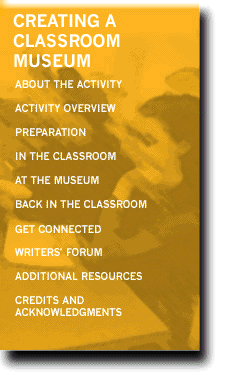

In the Classroom
![]() Clarify what is meant by the terms "museum" and "exhibition."
Clarify what is meant by the terms "museum" and "exhibition."
Ask students what constitutes a museum and present the definition of a museum
as a place in which objects--often those of a historical, scientific, or
artistic nature--are displayed. Next ask for their ideas about how museum
objects are arranged in their displays. Explain that they are usually tied
together thematically into an exhibition. Ask the students for examples
of exhibitions they've seen and the themes or subjects on which the exhibitions
were based.
![]() Have students brainstorm ideas for an exhibition.
Have students brainstorm ideas for an exhibition.
Divide the class into groups of four or five and have them suggest possible
themes for an exhibition of their own creation. To help the students get
started, you might want to suggest possible themes, such as When We Were
Babies, Who We Are, Where We Live, Our Ancestors, Our Neighborhood, The
History of Our School, Hobbies, and Friends.
Tell the students to think about objects they could bring from home that would support the themes they suggest. Such objects should be capable of conveying information about the theme to the audience. Explain that students can bring in many different kinds of objects, such as books, photographs, cassette tapes, clothing, letters, items that symbolize an important event, and even worn or broken items. If students can't think of appropriate items for a particular theme, that's a good sign that the theme may not work as the subject of an exhibition.
![]() Have the groups present their ideas.
Have the groups present their ideas.
Give the groups time to present briefly their exhibition themes. For each
theme, have the students point out why it would translate into a good exhibition.
Then have the class vote on the top two or three themes. Tell the students
to write down these themes, leaving a few inches of space between each one.
They'll be taking this list with them when they go to the museum.

